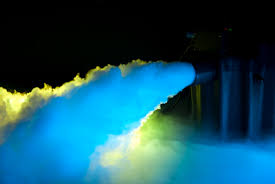When it comes to concert style lighting, if you don’t have haze, you don’t have much. You can take 100 moving lights and put them in a room, but with no haze, you’re going to have a severely UNDERwhelming effect. If you’re not familiar with haze, here’s a quick rundown.
First of all haze is not the same as fog, I hear people all the time talking about the “Fog” or the “Fog Machines” but the truth is, they are not the same thing. A fog machine (or a cheap hazer sometimes) is going to create a thick cloud of smoke, that usually is going to hang close to the floor.

A hazer on the other hand should produce a thin, even amount of haze that hangs in the air. The haze is made of small particles that help reflect light and make beams visible. Imagine if you had a laser pointer. You point the laser pointer at the wall, and all that you can see is a dot of light on the end of the pointer, and a dot of light on the wall wherever it hits. Without haze, that’s all that any concert or light show is going to be, you’ll see a little light coming from the lens, and some light wherever that beam ends, whether it’s on the walls, floor, or ceiling. With haze though, now you are getting all of the beams that are otherwise invisble in between surfaces. One lighting designer that I follow on Twitter, Daniel Connell, said
Haze gives mass to lighting. In a room without haze you only see light where it has a surface to reflect—usually meaning the lens of the fixture and the surface where the fixture is aimed. We know that there is light between the two but it is often barely perceptible—by introducing haze we can create individual beams of light that help give our lighting a perceived mass. This mass is what allows us to use lighting as scenery.
One thing you’ll quickly find when you start using haze is that it can sometimes have a mind of it’s own. I work in a large room with almost 4,000 seats, using 3 Ultratec Radiance hazers. There are so many different factors that can cause your haze to be a bit of a headache, anything that changes that airflow of the room can change how your haze looks, including your heating and cooling system, having doors open or closed, the temperature, or the humidity in your room. I’ve noticed that the warmer and more humid it is outside, the less I have to work to get nice looking haze in my room. During the winter, when it is really dry and cold, I’ll be running all of my hazers at 60-70% haze, instead of the normal 35-50%.
When purchasing a hazer, I would highly recommend getting one that has onboard DMX control. During a typical show, depending on all of the factors I listed above, you may have to make changes to your haze settings constantly, so being able to control it from your console instead of having to run to the machine all the time is a great asset!
Happy hazing!










Great points! We too use the Radiance hazer (my Martin K1 just came in) and I’ve noticed in my venue when it’s cold outside, the haze goes to a certain height and creats about a 1′ blanket about 20′ above the seats. It looks cool, but not for a concert. In this situation I find it more useful to turn the A/C or heat on to get it blown around a bit.
Yeah, we get that too sometimes. The problem in my room is we have an “advanced” HVAC system that is totally automated, so I have no direct control over it other than to be able to change the temperature that it is set at, which is hard to do during a service without making things uncomfortable in there
“Haze for lights is the equivalent of reverb on a microphone.”
Don’t remember where I heard this quote, but it’s pretty darn accurate! Haha
Do you like your hazers?
Yeah, they work great, they are easy to clean, and they have an outlet in the back of them that you can plug a fan into, then you can control the fan via DMX. We have 6 of them at our church between the different departments.